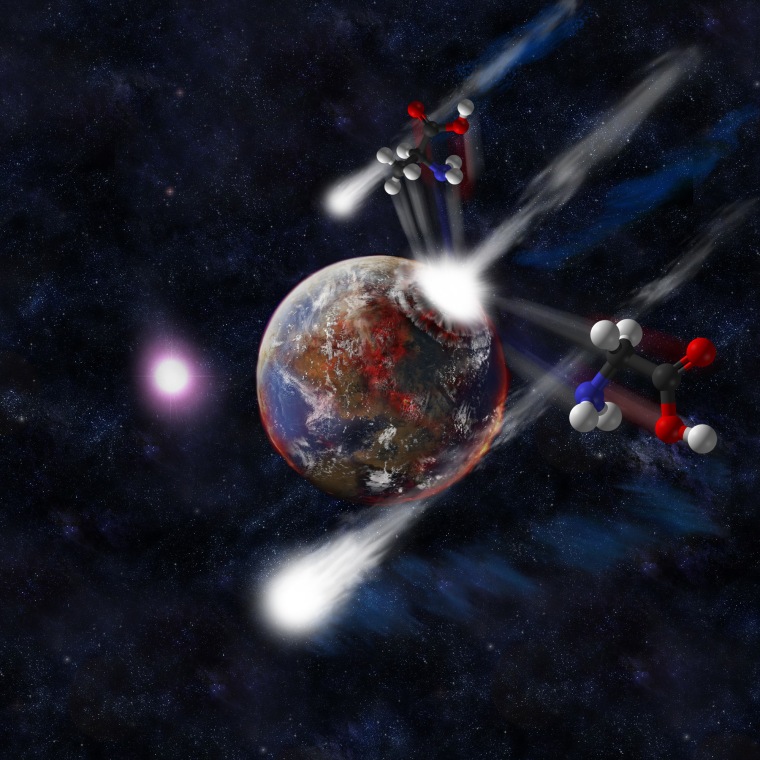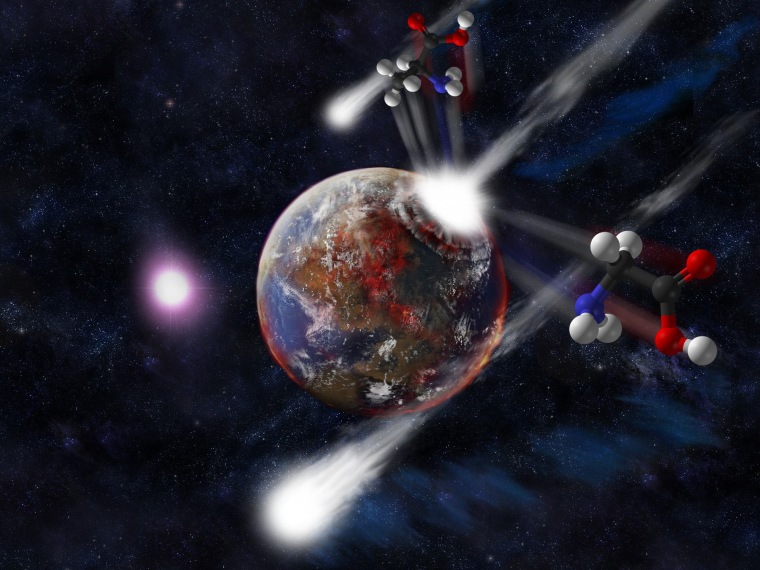
Scientists fired steel balls into blocks of ice with a glorified BB gun to prove that cometary impacts could have created the chemical building blocks of life on ancient Earth. Or on the icy moons of Saturn and Jupiter, for that matter.
The experiment provided further support for the idea that the stuff of comets, plus the heat of impact, would be enough to cook up amino acids.
"This process demonstrates a very simple mechanism whereby we can go from a mix of simple molecules, such as water and carbon dioxide ice, to a more complicated molecule, such as an amino acid," the University of Kent's Mark Price, one of the leaders of the experiment, said in a news release. "This is the first step toward life. The next step is to work out how to go from an amino acid to even more complex molecules such as proteins."
The study was published online Sunday in Nature Geoscience.
The blast of life
For years, researchers have been laying out their evidence for what's known as the shock-synthesis hypothesis, which suggests that the origins of life could have drawn upon relatively simple chemicals in comets. It's even possible that comets delivered ready-made amino acids to Earth, and that the chemistry created on impact built them up into even more complex combinations.
Researchers have run computer simulations and heated up lab solutions to test the hypothesis, but "this is the first study that looks at a cometlike mixture under high pressures and temperatures," said Nir Goldman, a researcher at Lawrence Livermore National Laboratory who is a co-author of the latest study.
During a series of experiments spanning almost a year, Price, Goldman and their colleagues mixed up a batch of pristine water and carbon dioxide ice that was laced with ammonium hydroxide and methanol, two key compounds found in comets. Then they loaded sterilized steel balls into a light gas gun and fired the projectiles at the ice, at a velocity of up to 16,000 mph (7.15 kilometers per second). They also fired the balls at a different block of ice without the added chemicals, as a control for the experiment.
After the blasts, scientists immediately heated up the ice so that it evaporated away, leaving a chemical residue. "The result is, you get this kind of goop, and that goop is actually hard to analyze," Goldman told NBC News.
Guided by Goldman's simulations, the team found several amino acids in the goop, including glycine, norvaline, alanine and isovaline. No amino acids were found in the control ice. That suggested that the cometary chemicals were key to the reaction, and also showed that the amino acids weren't the result of contamination.
Blasts beyond Earth
How wide of a range of impacts would work? That's an issue to be addressed in future experiments. Study co-author Zita Martins, a researcher at Imperial College London, said "the catch is that these building blocks need the right conditions in order for life to flourish."
Goldman said comets can travel at speeds several times faster than 16,000 mph, but if comets dealt Earth a glancing blow, their effective impact velocities could have been in the right range. "They're not so high that you're just obliterating everything," he said.
The same mechanism could apply to cometary impacts on the moons of Jupiter (such as Europa and Ganymede) or Saturn (such as Enceladus or Titan). "This increases the chances of life originating and being widespread throughout our solar system," Goldman said.
Steven Benner, a chemist at the Foundation for Applied Molecular Evolution who played no part in the newly published research, said the study adds to decades of scientific research showing that amino acids can exist in meteorites and comets from outer space.
"As this new work shows, amino acids, once formed, are relatively stable to further degradation," Benner told NBC News in an email. "This is unlike ribose, for example, which is part of a genetic molecule. Unfortunately, it is not clear that proteins built from amino acids can 'do' genetics."
More about life's chemistry:
- 'We are all Martians': Chemist's claim stirs debate
- Comet strikes may have jump-started life on Earth
- NBC News archive on astrobiology
In addition to Martins, Price and Goldman, the authors of "Shock Synthesis of Amino Acids From Impacting Cometary and Icy Planet Surface Analogues" include Mark Sephton and Mark Burchell.
Alan Boyle is NBCNews.com's science editor. Connect with the Cosmic Log community by "liking" the NBC News Science Facebook page, following @b0yle on Twitter and adding +Alan Boyle to your Google+ circles. To keep up with NBCNews.com's stories about science and space, sign up for the Tech & Science newsletter, delivered to your email in-box every weekday. You can also check out "The Case for Pluto," my book about the controversial dwarf planet and the search for new worlds.
